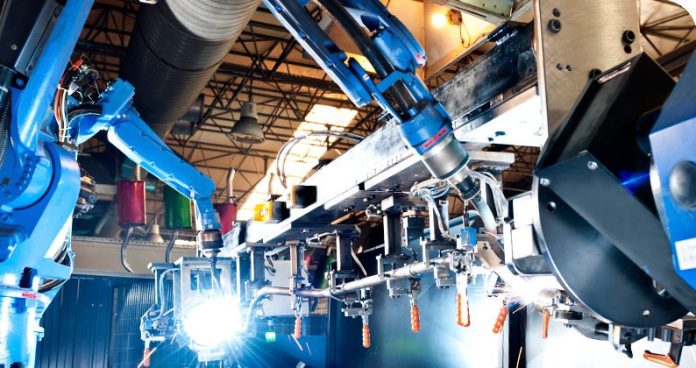Research house Strategy Analytics has produced a report, in conjunction with low-power wide-area (LPWA) network provider Actility, that considers the opportunities and the challenges of internet-of-things (IoT) technologies in smart manufacturing, and the broad industrial sector.
The benefits of digital technologies, including advanced data analytics techniques, are well trailed by technology vendors, promising to reduce costs, improve maintenance and efficiency, and transform logistics across a wide range of sectors, including automotive, manufacturing and processing, security and utilities.
This industrial revolution will be like nothing we have seen before, says the World Economic Forum, worth $6.8 trillion to the global economy, more than the value of the entire consumer internet market. Predictions are wildly divergent, however. The GSMA says the global IoT market will be worth $1.1 trillion in revenue by 2025.
Cisco released a study as far back as 2013, which still makes it into slide decks at trade shows and in sales meetings, that says manufacturing alone will capture as much as 27 per cent of the total value from the $14.4 trillion ‘internet of everything’
Rising confidence in the industrial sector’s appetite for enterprise IoT solutions, including those based on emerging LPWA wireless technologies, encouraged Ericsson in June to double it forecast for cellular LPWA connections to 3.5 billion by 2023, from around 0.6 billion million today, and from a year-ago 2023 forecast of 1.8 billion units.
Matt Wilkins, senior analyst for enterprise and IoT research at Strategy Analytics, and the author of the report, says the crazier forecasts around the economic opportunity afforded by industrial transformation are way off the mark.
“It can and will bring great benefits to businesses of all kinds in the coming decade. However, to refer to it as a market in the trillions of dollars is overly optimistic. Claims the IoT market has progressed from tentative to mainstream are not supported by our enterprise deployment research, as yet,” he explains.
Strategy Analytics says the unspecified ‘industrial vertical’ represents an opportunity of only eight per cent of the total IoT market. There remain major challenges and roadblocks, before smart manufacturing technologies take deeper root.
None are insurmountable, her says, but they are more real, and fiercely contentious for industrial operations, than the hyped forecasts from agenda-driven technology vendors. Here, handing over to Wilkins himself, Strategy Analytics considers six major challenges for IoT technologies in the wider industrial market, including the manufacturing sector.
Enterprise IoT Insights is hosting a webinar on August 22, 2018, about the role of digital technologies in industrial transformation in manufacuring. Register / listen here to experts from ABI Research, Hitachi and PTC, among others, to discuss seminal use cases and best practices that are setting the digital agenda for the industrial sector.
1 | INTEGRATION
“The industrial segment is a strong advocate of the ‘if-it-ain’t-broke-don’t-fix-it’ idiom. Machines are maintained and used for many years, often beyond a period whereby parts are easy to obtain. They remain part of the environment because replacing them would cost hundreds of thousands of dollars, an expense which smaller industrial companies find it very hard to justify when the existing machine works perfectly.”
2 | CONNECTIVITY
“Wired connectivity is favoured in industrial, so with IoT pushing wireless connectivity this can represent a see change in the network infrastructure design. The use of wireless networking may lead to concerns over security.”
3 | FINANCING
“As with all IoT deployments, the issue of financing is key, with pro-IoT advocates within the company asking management to fund trials and ultimately full deployments. Convincing management for funding based on theoretical benefits which are not yet demonstrable in the actual facility is challenging. Quantifying benefits must always show the correlation of operational improvements to the bottom line.”
4 | SKILLS
“Having gained management sign-off and funding, the next question is who will make it happen? At this point the issue of skills arises, specifically whether the company has the skills in place to design, develop, implement, fine tune and maintain an IoT deployment. The range of skills required are considerable, from system architects with a detailed knowledge of manufacturing environments, systems integration specialists who can facilitate the implementation of the hardware into the manufacturing environment, to data analysts.”
5 | FRAGMENTATION
“The theme of fragmentation is one of the key issues the IoT industry as a whole must strive to deal with in an effort to simplify selection and planning. Alliances and partnerships continue to be struck in an effort to broaden IoT capabilities and offer options when engaging with companies looking to deploy IoT. The challenge in designing and developing IoT solutions for the industrial market is underlined by the varied list of partnerships being formed across hardware and software vendors, telecommunications firms, through to engineering and industrial companies.”
6 | SECURITY
“The security of IoT concerns any device or any part of the IoT process flow where data is stored, transmitted or analyzed. The mantra ‘protect the production line’ rings loud here. If the network can be accessed, machines could potentially be hacked; the production process could be interfered with, and in the worst case scenario, halted. Poorly handled security in an industrial IoT environment could result in a severe lack of trust between partners, upstream and downstream.”

